Condom measure heads to the ballot
August 9, 2012

In spite of wide-ranging concerns, a measure to require condoms on porn shoots will go before voters.
An initiative to mandate condom use in adult film production moved this week to the November ballot, despite predictions that it could expose the county to lawsuits and leave taxpayers picking up the tab for some of the program’s costs.
The measure also raises potential free speech questions; compelling filmmakers to put condoms in their movies could be construed as an infringement of the First Amendment.
Acknowledging concerns about the measure, the Board of Supervisors voted to 3-1-1 Tuesday to place it on the ballot, after supporters gathered enough signatures to easily qualify it earlier this month. Supervisor Gloria Molina voted no and Supervisor Mark Ridley-Thomas abstained.
“We’re all in favor of porno stars using condoms,” Molina said, “but the issue is liability for the county.” Molina noted that existing law requires the state, not the counties, to enforce workplace safety, and said that the county already pays out more than $100 million a year in liability claims.
Backed by Los Angeles AIDS activists, the ballot measure would require the county to issue and enforce public health and film permits for porn producers, whose performers would have to use condoms on their sets. Violators could be fined and/or charged with misdemeanors.
The initiative addresses longstanding concerns about unsafe sex in the San Fernando Valley’s burgeoning porn industry, and qualified for the ballot with more than 370,000 signatures.
It has been dogged, however, by concerns about jurisdiction and enforcement. Workplace safety in California is currently regulated by federal and state law and enforced by Cal/OSHA. And most adult films are shot quickly and without permits, often in private homes and garages, which makes it hard to police them.
Those concerns were echoed in reports from the Department of Public Health and County Counsel. The Public Health analysis noted that, unlike, say, catering truck owners, adult film producers rarely disclose their locations in advance, and their competitors rarely know enough about their procedures to notify the county of suspected violations. Thus, even with laws in place, it would be difficult to protect many if not most adult film performers.
Meanwhile, County Counsel John Krattli noted that if the initiative passes, the county would be vulnerable to lawsuits, not only from the measure’s backer, AIDS Healthcare Foundation, which could sue if enforcement fails, but also from the adult industry, whose lawyers confirmed the threat on Tuesday.
“This is an unconstitutional and unwise attempt to fix a nonexistent problem,” said Allan Gelbard, a First Amendment lawyer. “What’s it going to cost the county if you enact it and you are sued and lose? . . . I believe the county would be on the hook.”
Although the measure would require the adult film industry to foot the bill for the enforcement, the Public Health analysis found “significant” startup costs attached to the measure that are unlikely to be covered by the permitting fees built into the initiative because so few adult film producers bother to apply for permits.
Among other things, the report noted, the county would have to set up training programs for producers, create a permitting and review process, maintain an industry database, conduct regular inspections and spot checks, staff a complaint line, assess fines and administer appeals.
The establishment of an Adult Film Public Health Permit Office would cost at least $291,466 a year, not including the costs of confiscation, law enforcement and evidence warehousing, the report said.
“If 10 public health permits were issued, the two-year costs translate into a fee of $58,294 per permit,” the report noted. Even if 50 adult film producers were to apply for permits, the per-permit fee would still be more than $11,000.
Advocates for the measure insisted, however, that it is necessary for porn performers to be ensured of a safe workplace.
Posted 7/24/12
Get the latest on Expo Phase 2
July 11, 2012
With work underway on the second phase of the Expo Line light rail project, the Expo Construction Authority is hosting a community meeting near the train’s eventual final destination in Santa Monica.
Project staffers will present a 15-minute update on the project design and upcoming construction activities before shifting to an open house-style discussion session. Renderings of the project’s progress will be displayed and staff members will be on hand to answer questions. The meeting takes place on Wednesday, July 18, at 6:30 p.m., in the East Wing Meeting Room of the Santa Monica Civic Auditorium, located at 1855 Main Street.
Major construction on the project is expected to begin in late July or early August. When the line opens, it will offer a 46-minute ride from downtown Los Angeles to Santa Monica.
Posted 7/11/12
The beach bus is back
July 3, 2012
When the second phase of the Expo light rail line opens in a few years, residents of Los Angeles County will be able to take the train to the beach. In the meantime, the Summer Beach Bus is back, courtesy of the Los Angeles County Department of Public Works.
In the Third District, the Topanga Canyon Beach Bus offers a route that serves the West San Fernando Valley and Topanga Canyon. The bus also connects to the Metro Orange Line at Warner Center Station, providing beach transit access to even more of the Valley and beyond, linking its riders to the sands of the Topanga, Will Rogers and Santa Monica State Beaches.
Out of 8 routes countywide, only the Topanga and East L.A. routes do not require reservations. All others must reserve seats online at www.lagobus.com or by calling (626) 458-3909. The Topanga Canyon Beach Bus is $2 for a round trip and half price for seniors and disabled people. Other routes range in price up to $6 per round trip. The Topanga Beach Bus will run Mondays through Saturdays until Labor Day.
Posted 7/3/12
Riding high as Expo hits Culver City
June 27, 2012
As the Expo Line started service to Culver City this week, Metro officials announced that overall rail ridership is on a roll in the county, with more than 100 million boardings projected this fiscal year.
Metro CEO Art Leahy said those levels haven’t been seen since World War II, and he credited the system’s expansion—along with more frequent trains, increased night hours and better maintenance—with drawing more riders to local light rail and subway lines.
The region’s rail expansion includes the Expo Line, which opened in April and averaged 11,347 daily boardings in May, its first full month of operation.
That’s low compared to opening month figures for other Metro light rail lines, including the Blue Line (19,600 in August, 1990) or the Gold Line (18,364 in August, 2003.) But Expo opened without two of its stations—Culver City and Farmdale, both of which rolled out the welcome mat Wednesday, completing the initial 8.6-mile stretch of the light rail line.
“With the opening of these two stations, we anticipate a substantial increase in ridership,” Metro spokesman Rick Jager said.
In Culver City, local bus lines have been reconfigured to make it easier for passengers to switch to the train at the station, which is expected to generate about 3,000 additional boardings a day.
Leahy said it takes time to build ridership on any new line. But he added that the growing reach of the rail system is making the train an increasingly desirable travel option in a car-clogged metropolis.
“You can go to Hollywood, the Valley, East L.A., Long Beach and now Culver City,” he said.
The record ridership numbers predicted for the fiscal year ending June 30 show the power of investing in the system, Leahy said, although he acknowledged that high gas prices are a factor, too.
And the system is still growing. Work on Expo’s second phase, to extend the light rail to Santa Monica by 2015, is now underway.
“We’re seeing the cumulative effect of what’s going on,” Leahy said. “We’re really achieving a critical mass.”
Watch dignitaries including Supervisor Zev Yaroslavsky inaugurate the new Culver City station in this video.
Posted 6/20/12
Blazing a path by the new Orange Line
June 27, 2012
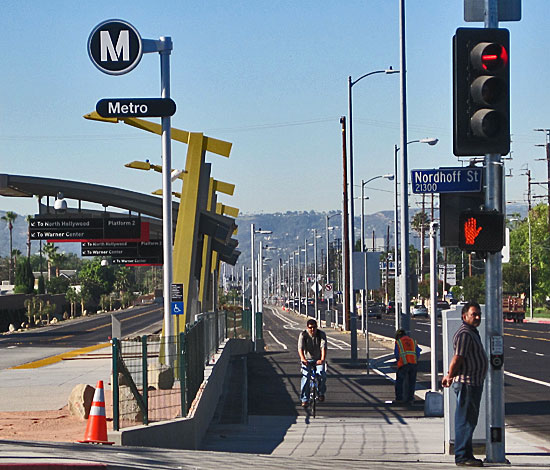
Even before it opens, the new Orange Line bike/pedestrian path is getting a workout. Photo/Dave Sotero, Metro
Bus passengers aren’t the only ones getting a slick new ride with this weekend’s opening of the Orange Line Extension.
The rapid transit busway features a dedicated bicycle/pedestrian path that’s being billed as the longest “transit-adjacent” bikeway of its kind in Los Angeles County. The path runs next to the new 4-mile northward extension of the Orange Line, which opens to the public this weekend with free bus rides on Saturday and Sunday, and connects with the original line’s 14-mile bikeway for a total of 18 miles. (By comparison, the newly-opened Expo Line bikeway is 6 miles long; it will grow to 16 miles when the line is completed to Santa Monica.)
Even before the ribbon is cut on the Orange Line Extension—which extends the popular busway northward from Warner Center to Chatsworth—cyclists and walkers have been giving the new path a workout. One project official counted 257 bicyclists and pedestrians out enjoying the new 4-mile stretch on a recent evening.
“I use it every day,” said Manny Samuel. “It’s safer for me [than the street] with all these cars.”
For Samuel, the bikeway even makes possible an old-fashioned midday break that most modern-day Angelenos can only dream of. “I’m going home for lunch,” said Samuel, who works at a nutrition research company, as he prepared to pedal from Canoga Park to Woodland Hills.
Dan Flores, out walking on a recent sunny day, said he’s already hitting the path for an average of six or seven miles a day—on foot or on bike. It’s great exercise—and a nice way to beat high gas prices. “I have a big giant truck that costs me $10 just to turn it on,” he said.
For teenagers like Anthony Winn and Gianni Darienzo, the new bike path has emerged as the preferred route to that time-honored summer destination: the mall. Compared to getting a lift in the car, “riding a bike’s better,” Darienzo said, as he and Winn returned from a trip to the Westfield Topanga Shopping Mall.
Most of the wide, asphalt-surfaced path has separate, dedicated lanes for bicyclists and pedestrians. Still, there are some “multiuse” areas in which walkers and cyclists will share space. Wider-than-usual 6-foot curb ramps also will allow cyclists and pedestrians to get on and off the path more easily, especially when it’s crowded.
Landscaping remains nonexistent along much of the path, but several hundred trees, such as incense cedars and Chinese flame trees, are set to go in soon, along with drought-tolerant plants including trailing rosemary and fortnight lilies.
The overall bus project is coming in ahead of schedule and under budget by $61.6 million, having used just $154 million of the $215.6 allocated. The acceleration was made possible, in large part, by the passage of Measure R by county voters in 2008, said project manager Hitesh Patel. Patel said the bicycle/pedestrian path is only part of a host of healthy and environmentally friendly elements incorporated into the new busway, which also has some solar-powered lighting panels, bioswales to naturally filter runoff water and even recycled construction debris from the 405 Project, which has been crushed and used as an underground base.
Those who want to ride the new busway extension can do so for free on Saturday, June 30, and Sunday, July 1. (The free rides are being offered only on the extension portion of the Orange Line running from Canoga Park to Chatsworth.) There also will be family-friendly festivities from 10 a.m. to 4 p.m. on Saturday at the Canoga Park and Chatsworth stations.
Those include a group ride with Valley Bikery, which sets out from the Canoga station at 1 p.m. and finishes at the Chatsworth station.
Nathan Baird, bicycle coordinator for the Los Angeles Department of Transportation, said he expects to see cyclists using the bike path—and the Orange Line itself—in a variety of ways.
“Having the bike path right next to the transit gives you a whole slew of options,” he said.
And the sheer 18-mile length of the path is a major plus, he said.
“The miles are important,” Baird said. “It connects across the entire Valley.”
Those connections eventually will go even further.
In the not too distant future, he said, cyclists will be able to start on the Browns Creek bike path in Chatsworth, connect with the Orange Line bikeway, travel along dedicated bike lanes through stretches of Los Angeles and Burbank and end up on the L.A. River bike path, which in turn will open up new connections stretching all the way to Long Beach.
As Patel, the project manager, puts it: “It’s going to be a wonderful asset for the San Fernando Valley…and for bicyclists, runners and nature lovers across the county.”
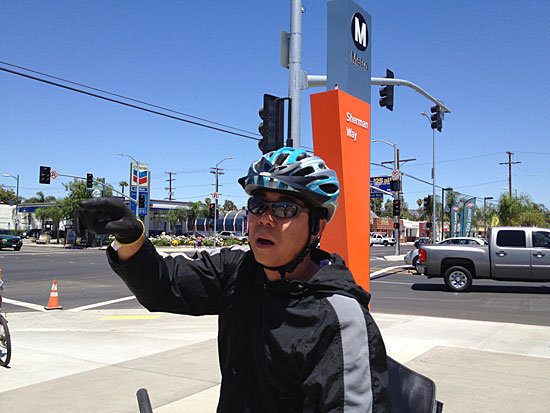
Manny Samuel, who lives in Woodland Hills and works in Canoga Park, uses the bikeway to ride home for lunch.
Posted 6/27/12
Expo opens to Culver City on June 20
June 5, 2012
The Expo Line hits full strength on June 20, when the light rail’s Farmdale and Culver City stations open to the public.
The opening completes the 8.6-mile first phase of the line, which debuted with stations originally extending as far west as La Cienega on April 28. A second phase to extend the line all the way to Santa Monica is now being built.
The elevated Culver City station opens up a gateway to the city’s popular eateries and other attractions, including the quirky Museum of Jurassic Technology.
The Farmdale station, near Dorsey High School, was not originally part of the line, but was added later, after the Public Utilities Commission approved a station at the site. The Culver City station, original conceived as an interim station for phase one, changed course and became an elevated, permanent station after state funding became available.
Expo CEO Rick Thorpe said a 600-space park-and-ride lot will open along with the Culver City station, and bus lines in the area will be realigned to feed into it.
“It should be a very, very heavily used station,” he predicted.
The stations will open at noon on Wednesday, June 20. That means that participants can ride Expo to Culver City’s Third Wednesday “Summer Solstice” Happy Hour, with attractions including music from a six-string electric cello, an open house at the Kirk Douglas Theatre, dancing and all kinds of liquid refreshment at local watering holes.
Posted 6/5/12
Rollin’ on the river
June 5, 2012
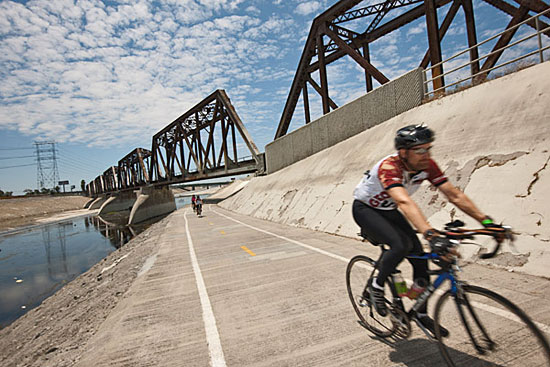
The L.A. River Ride bridges the past, present and future of the cycling revolution. Photo/Minami Pictures
Years before Los Angeles streets went car-free for the freewheeling festivities known as CicLAvia, bike advocates were already forging a path with the L.A. River Ride.
Now in its 12th year, the L.A. River Ride, which takes place on Sunday, is not just the granddaddy of local cycling activism. It’s also riding a growing wave of bike popularity, with new and veteran riders pedaling together in celebration of a still-evolving regional cycling culture.
“Committed cyclists ride by ourselves every day,” said Joe Linton, one of the event’s founders, along with Ron Milam and Chuck Arnold. “Group rides make us feel more connected with each other—and are a great way to welcome newer, less experienced riders into the fold.”
Since its beginning, the ride has generated support for two causes—bike advocacy and the health of the L.A. River. The event is now the yearly fundraiser for the Los Angeles County Bicycle Coalition, a nonprofit bike advocacy organization.
“We were one foot in river activism and one foot in bike activism,” Linton said.
In the late 1990s, before the first River Ride, the three activists organized a series of prototype events with Friends of the L.A. River and Occidental College. According to Linton the events were successful, and gave bikers a chance to see a “natural” side of the L.A. River.
“One of the big things about the L.A. River is that people don’t know where it is,” said Linton. “I think a lot of people imagine it is all concrete like in the movies Terminator and Grease.”
Although the ride draws attention to the river, its main thrust has always been about expanding bikeways. To help get federal funding for the inaugural River Ride in 2001, Linton pitched the goal of a continuous 50-mile bike path along the river, from the San Fernando Valley to Long Beach.
In 1998, around the same time the ride was beginning to take shape, Linton and Milam co-founded the Los Angeles County Bicycle Coalition. According to J.J. Hoffman, a coalition member who has organized the River Ride since 2005, the event and the organization have grown in symbiosis. The first ride drew 780 cyclists. When the bike coalition expanded in 2007, attendance doubled. Organizers expect this year’s event to draw about 2,500 cyclists.
The goal of a 50-mile continuous path along the L.A. River remains elusive, but there has been progress. When the event began there were 18 miles of bike path, built in the 1970s. Now there are nearly 30 miles of path, with another 1.5 miles to be added later this year as the West Valley River Bike Path moves towards completion. When the Metro Orange Line Extension to Chatsworth opens on June 30, 4 miles of bike path perpendicular to the river will open with it, eventually connecting to a part of the river path planned for the future. Hoffman says the cycling community is eager to keep adding to the total.
“Having 50 miles of uninterrupted bikeway in Los Angeles would be like having our own bike freeway,” said Hoffman.
This year’s ride takes place on Sunday, June 10. Registration starts at 6:30 a.m. The route will take riders along the river where path currently exists, and will detour around parts of the river where there’s no path yet. Security will patrol the route with radios to ensure riders stay safe. Helmets are required, and technical and medical support will be available along the ride.
There are 7 different ride options to choose from, from a 100-mile Century Ride to a 15-mile Family Ride and an even shorter Kids’ Ride. Registration ranges from $50 to $65 except for the Kids’ Ride, which is free. Most rides begin and end at the Autry Center in Griffith Park, where festivities will be held, including an International Food Fair, an “Eco Expo,” live music and a raffle. Rest stops in Elysian Valley, Hollenbeck Park, Maywood Recreational Park, Dill’s Park and Long Beach Shoreline Park will also feature food, music and entertainment. Visit the event page for more details.
Cyclists are encouraged to raise money by having people sponsor their rides. For the first time, this year the top fundraiser will win a 10-day guided bike tour of the Tuscany coast in Italy, and runners-up will win bike parts and apparel. Those who want to support the cause but can’t join in can sponsor the ride or make a donation.
This year’s grand marshal, Bobby Gadda, serves as the President of the Board of Directors of CicLAvia. Gadda said both events offer something unique:
“Both CicLAvia and the River Ride are all about families enjoying biking in the streets, using the public space in a different way.”
This Sunday, Gadda will lead rides out from Griffith Park, high atop his famous tall bike. There will be a lot of folks behind him, and even more behind a growing, healthy movement from gas power to pedal power.
Posted 6/5/12
These smooth operators beat the guys
May 31, 2012
There are no bucking broncos or grease-painted clowns at this rodeo, and cowboy hats fall well outside the rigorous official dress code. There are, however, significant bragging rights on the line.
And this year, the challenge of lassoing some global recognition for the Metropolitan Transportation Authority at the International Rail Rodeo is in the train-tested hands of two women: Sheila Celestain and Carolyn Kelly.
The veteran Blue Line operators earned their trip to this week’s competition in Dallas by taking top honors in Metro’s in-house train rodeo earlier this year. They confronted obstacles on a closed rail course, mastered all the verbal and visual instructions that were thrown at them, and excelled in categories ranging from uniform inspection to train evacuation procedures to the smoothness of the ride.
Women have won Metro’s rail rodeo before—in 1998 and 2006—but this is the first time an all-female slate swept the internal contest, with the top two finishers earning the right to compete in “the show.”
Celestain, Metro’s top train operator this year, and Kelly, the runner up, are part of a culture in which women operators are still very much in the minority, and where the diplomatic skills needed to deal with thousands of daily passengers often are as essential as the technical finesse required to maneuver a 100,000-pound train car.
Women make up just 25% of the nearly 300 train operators currently on Metro’s staff.
But they often bring something special to the job, says rail division transportation manager Tom Jasmin.
“Over the years, I’ve noticed that women are more intuitive and they pay attention to detail more than I think men do,” he says. “They’re a little smoother on the braking, smoother on the acceleration…it’s just the smoothness of the ride you get. And when they get on the intercom, they’re a little more patient.”
Whatever happens in Dallas, it’s been quite a year for Metro’s top twosome. They were temporarily pulled off their Blue Line duties to become part of an elite crew chosen to test drive the new Expo Line as it prepared to open last month. They’ve transported VIPs, posed for photos with beaming officials and had their work immortalized in video. (Check out Celestain’s test ride with Supervisor Yaroslavsky here and catch a glimpse of Kelly driving the train on Expo’s inaugural run here.)
“Best year I’ve ever had since I worked for Metro,” says Celestain, who, like Kelly, is a 22-year Metro veteran who spent years driving a bus before making the leap to trains more than a decade ago.
If they’re worried about what’s coming their way at the international competition, it doesn’t show. In an interview Tuesday on the platform of Expo’s La Cienega station, both women seemed cool, confident and matter-of-fact. They also looked textbook-perfect: immaculately-pressed light blue shirts, dark sweater vests, regulation black shoes. (Hello, uniform inspectors.)
“I’m not sweating it at all. I’m gonna get in there and do what I’ve gotta do,” says Celestain, 56.
“I think we have a good chance,” adds Kelly, 54, who notes that the only potentially worrisome obstacle is having to use unfamiliar trains in Texas, not the Nippon Sharyo P865s and Siemens P2000s they drive at home.
Both credit their time on the Blue Line—Metro’s oldest, longest and busiest light rail—with giving them confidence to face whatever comes their way.
“Anything can happen on the Blue Line at any time,” Kelly says.
Adds Celestain: “After you work over here so long, you learn to just roll with the punches.”
Their boss, Jasmin, thinks working on the Expo opening also may have given the women an edge, since it required driving in a construction zone, where attentiveness and quick reactions are essential and pressure is high.
The competition takes place on Saturday, June 2. Celestain will be driving the train for the L.A. team in Dallas, and her score there will be combined with the scores that she and Kelly rack up in other categories, including a written test. Separate awards are given for operator teams and maintenance teams. In the latter category, Metro is represented this year by Charley Houck of the Blue Line, and Jose Padilla and Alan Addie of the Green Line.
The Metro train operators and “maintainers,” as they’re known, could also be in the running for the event’s annual Grand Champion Award, an honor last brought home by Metro in 2009.
Before they left for the big competition, Celestain and Kelly joked about sensing jealousy from the “haters” among their male colleagues. Just kidding: everybody is pulling for them, they say. But the guys—like the women themselves—do seem surprised the duo made it to the top their first time out as Metro rodeo contestants.
“They can’t believe it!” Celestain laughs. “They go every year, and this is the first year we went.”
Updated 6/5/12: Celestain and Kelly brought home the bronze, placing third behind train operators from Dallas and St. Louis. All of the winners were hailed as “stellar role models to their peers nationwide” by Michael Melaniphy, president and CEO of the American Public Transportation Association. “They are the best of the best in rail operations and maintenance,” he said.
Posted 5/30/12
Orange Line, golden age
May 29, 2012
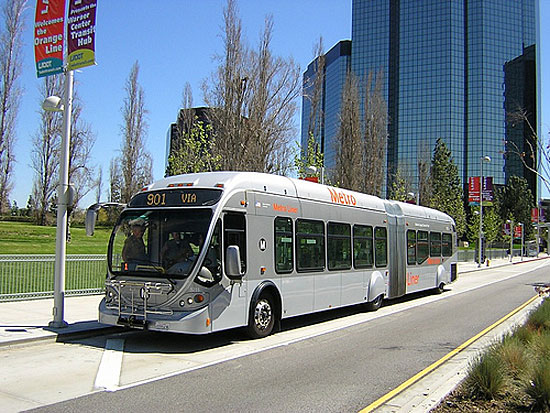
Starting June 30, the Orange Line Extension rolls northward as part of the county's public transit boom.
Sometimes it’s hard to spot a great leap forward when you’re sitting in bumper-to-bumper traffic.
But that’s what we’re living through these days in L.A. County.
Our public transportation system, a national laughingstock just a generation ago, is on a roll. I don’t think it’s an overstatement to say we’ve entered a golden age of public mass transit. I’m not arguing that our notorious traffic congestion is likely to disappear anytime soon; as long as our population keeps growing and 16-year-olds continue to head down to the DMV to get their first driver’s licenses, that’s going to be a fact of L.A. life. But we’re finally in a position to offer the traveling public some meaningful alternatives to sitting and stewing on our freeways and surface streets.
The Orange Line Extension is the latest case in point. This rapid transit bus line opens to the public on Saturday, June 30, with free rides and festivities. Its four-mile route, which runs from Warner Center to the Metrolink train station in Chatsworth, is a northward extension of the original Orange Line, which opened in 2005 to rave reviews and significantly higher-than-projected ridership. (It now stands at more than 25,000 boardings a day.)
The Orange Line Extension—which is coming in under budget and ahead of schedule—promises to continue that success story, offering thousands of new riders not just a better commute but a better quality of life.
As important as this project is to bringing transportation alternatives to our traffic-jammed region, it’s only a small part of what’s now happening across Los Angeles County. Look in just about any direction, and you’ll see signs of a transit revolution.
The long-held dream of building a Westside Subway moved into high gear last week as Metro’s Board of Directors voted to approve the project’s route, placing it on track to break ground as early as 2013.
Meanwhile, the Westside’s first light rail since the Red Car is now open for business. The Expo Line started carrying passengers between downtown and La Cienega in April, and will be reaching Culver City later this summer. Work also has begun on Expo’s second phase, which will extend the line all the way to Santa Monica.
On the other side of the county, the eastward expansion of the Gold Line is underway, with a dramatic bridge taking form across the 210 Freeway as the light rail rolls ahead toward Azusa. And projects ranging from the Crenshaw/LAX Line to the Regional Connector are moving closer to becoming a reality.
These projects—many of them made possible by county voters’ overwhelming approval of Measure R in 2008—are about so much more than moving us from Point A to Point B. Every time we build a mass transit alternative, we return precious time to the daily lives of real people. We restore choice to commuters who have been held hostage to the freeways. And we move our region toward a healthier, less car-dependent future.
I encourage you to hop onboard the Orange Line Extension when it opens June 30. And be sure to take a photo. You can say you were there as L.A. was making its move from public transportation punch line to public transportation powerhouse.
Posted 5/29/12




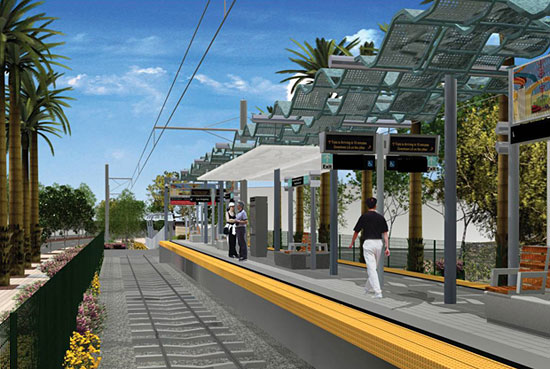

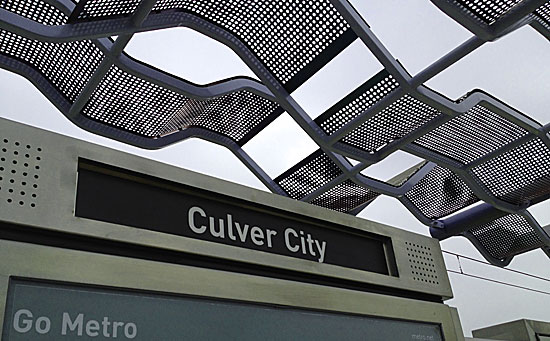
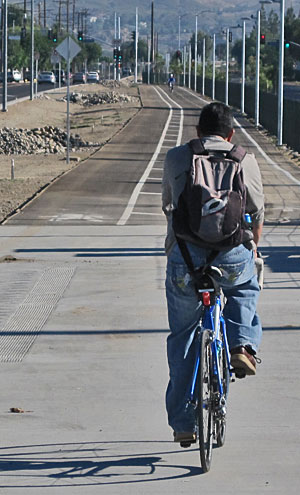

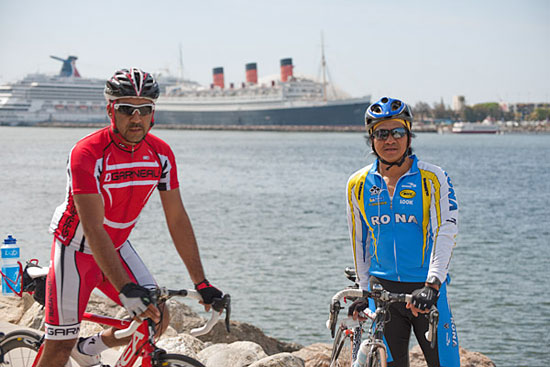
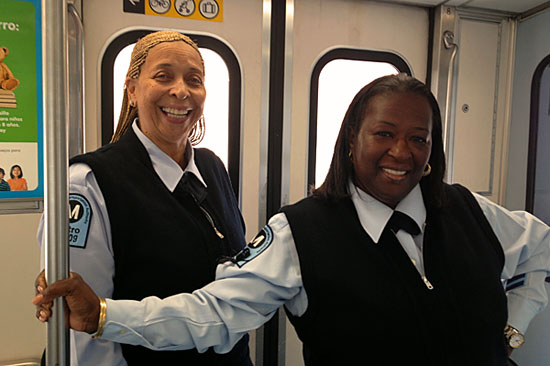
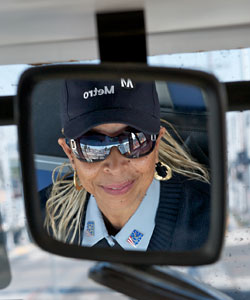
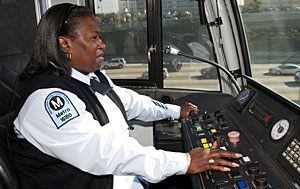







 405 bridge work causes a stink
405 bridge work causes a stink

